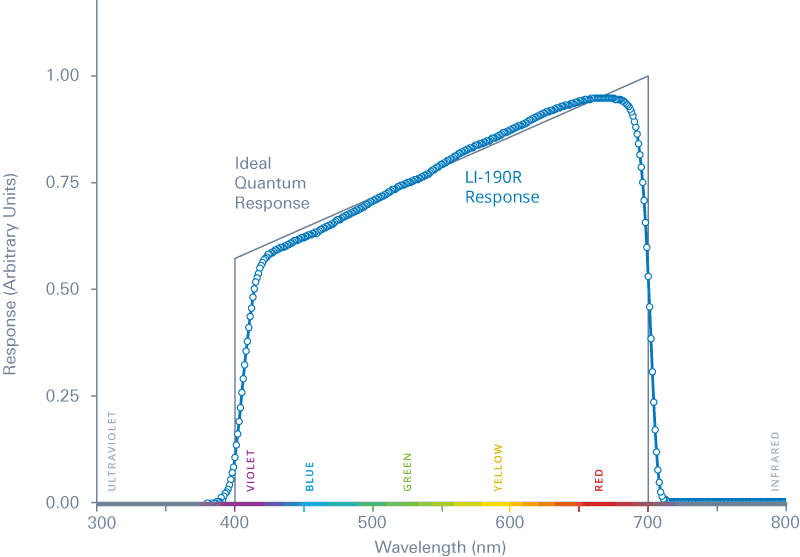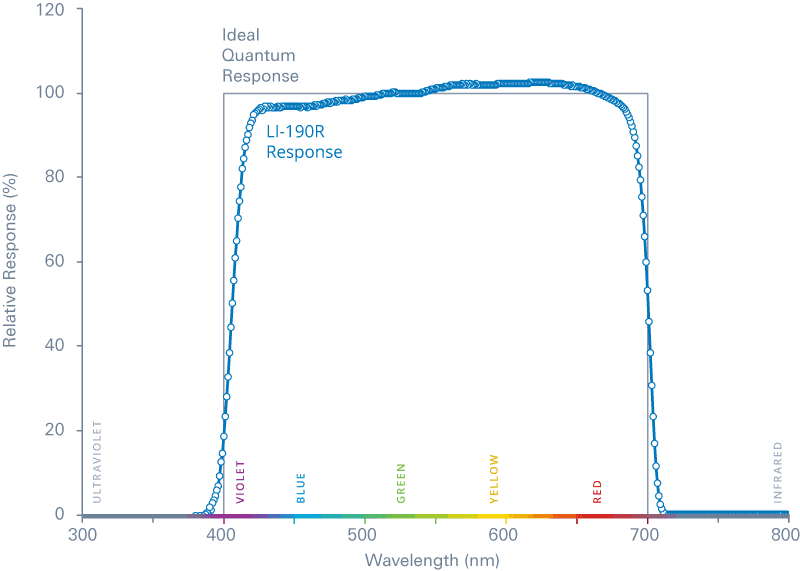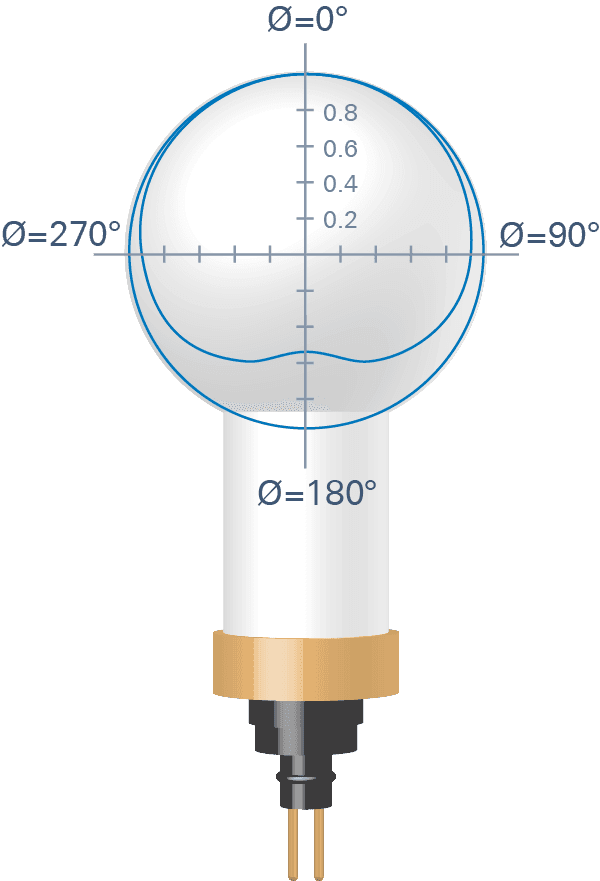Understanding Plant Health and Light Management Starts with Accurate Measurements
Measuring light and plant stress can influence desired plant characteristics—including growth rate, chemical composition, taste, and nutrition.
Light management is a critical factor in commercial greenhouse and growth chamber efficiency. Choose the LI-250Q package for spot measurements of photosynthetically active radiation (PAR) intensity and quantity with unrivaled accuracy.

Plant growth is driven by PAR, which occurs at wavelengths between 400 and 700 nm. Not all light contains PAR, and PAR requirements vary between types and growth stages of plants.
The LI-190R Quantum Sensor, included in the LI-250Q package, provides uniform sensitivity across the entire PAR waveband, delivering the most accurate PAR measurements of any sensor on the market.
The LI-190R Quantum Sensor measures PAR inside greenhouses and growth chambers with the same precision from the sun, artificial lighting, or both without the need for calibration or correction factors. Compatible artificial sources include incandescent and high-pressure sodium lamps, high-intensity fluorescent lights, and the rapidly emerging range of LED light systems.
The LI-250Q package allows you to capture the instantaneous flux of photons (µmol m-2 s-1) with wavelengths in the PAR range to assess whether your plants are getting enough light at any one point in time. This assessment depends on your unique lighting requirements and can be used to make informed light management decisions, including:


Expand your light measurement capabilities with data logging, long-term measurements, continuous PAR measurement, and automated calculation of Daily Light Integral (DLI) with the LI-1500 DLI Package.

An important lighting consideration is the total amount of light your plants receive daily, which cannot be easily extrapolated from instantaneous measurements. One of the most common ways of calculating total daily light is DLI, which reports a total number of moles (instead of micromoles) of photons per day (instead of per second).
Maintaining a consistent DLI based on your plant type and growth stage is critical for achieving ideal growth and maximum yield. However, the amount of supplemental lighting required to maintain a consistent DLI can vary dramatically throughout the year. Providing too little light may negatively impact growth and production, while providing too much light may also negatively impact growth while wasting costly energy resources. With the LI-1500 DLI package, you can ensure that you provide the correct light amount to optimize greenhouse production while conserving resources and being mindful of your bottom line.
Accurate DLI measurements require that measurements are taken at precise, regular intervals and use complex calculus to find the integral of the intensity-time curve. The LI-1500 DLI package greatly simplifies this process, automatically capturing data at the correct intervals and doing the math for you.
After programming your LI-1500 based on your light sensor’s calibration information, calculating DLI takes three simple steps:
Because plants use light from all directions, it’s useful to measure reflectance from the surfaces in your greenhouse, grow rooms, and chambers.
Originally designed as an underwater sensor, the LI-193SA Spherical Quantum Sensor also measures light in the air, providing insights on how to maximize the efficiency of your grow lights and reflective surfaces. Its compact size makes it easy to map light intensity and its impact on your grow in all areas of your space, including within canopies to map light reaching lower leaves. Use the LI-193SA with the LI-250A Light Meter and the 2222UWB-3 cable to capture PAR from a near 360° range.

Take precise, handheld spectral measurements with a polished and powerful interface ideal for the greenhouse grower on the move. Instant, one-click data capture provides actionable results in seconds.
Request a QuoteNot all light affects plant growth and reproduction the same way. Modifying the intensity of specific light bands can influence desired plant characteristics—including growth rate, chemical composition, taste, and nutrition.
The LI-180 Spectrometer allows you to record and optimize the spectral composition of your supplemental lighting, which can add significant value to your greenhouse or growth chamber operation.
Measure real-time changes from spectral manipulation, height adjustment, and plant positioning. In one click, the LI-180 records dozens of variables—such as PAR (as color-specific photosynthetic photon flux density (PPFD)), photon flux density (PFD), and irradiance (W/m2). Select a measurement to view details, such as ratios of red to blue or red to far-red intensity.

Compare the spectra of your lighting to one of multiple reference spectra. Reference spectra are based on pigments that are important for photosynthesis and morphology, such as chlorophyll a or beta carotene. Then adjust your lighting strategy to better match the pigment peaks for species-specific responses throughout your greenhouse. View a variety of tabular and graphical outputs immediately after capture and create custom views and ratios to see your variables of interest.

In addition to the lightweight and portable design, the LI-180 mobile application provides excellent flexibility. Connect any Wi-Fi enabled device to quickly transfer data or customize your display by choosing variables of interest to you. Desktop software enables in-depth analysis, continuous or timed capture configuration, and file management capabilities.

Proper management and understanding of plant physiological stress at different points in the growth cycle can lead to desired characteristics. The LI-600 Porometer/Fluorometer takes high-throughput stomatal conductance and chlorophyll a fluorescence measurements in seconds. Quickly survey greenhouse plants, using its barcode scanner to easily track and organize measurement data from rows or specific plants.
Request a QuoteStomatal conductance and chlorophyll a fluorescence measurements can serve as an indicator of a plant’s genetic makeup and its physiological response to greenhouse conditions. Both measurements can help identify stressors and contribute to a more complete picture of a plant’s health.
Measuring Massive Quantities of Plants
Horticulturist Jake Emling used the LI-600 to measure entire greenhouses of tomato, lettuce, and Cannabis species.
Growing research, responsibility, and relationships at Michigan State
Dr. Roberto Lopez and his lab discuss making discoveries and using science to connect with others.
Must-have meters
LI-COR greenhouse light measurement products were recently featured in a GrowerTalks cover story.
Built upon 45+ years of light measurement experience, other LI-COR instruments for greenhouse and growth chamber research and commercial production include:

Precise, stable infrared gas analyzers ideal for greenhouse monitoring.

Nondestructive measurement and logging device for leaf area.

Precision gas exchange and chlorophyll fluorescence measurements with the most advanced photosynthesis instrument available.

Efficient, high-throughput area measurements with user-selectable area resolution.
Back to Light Measurement Products
Continue Reading